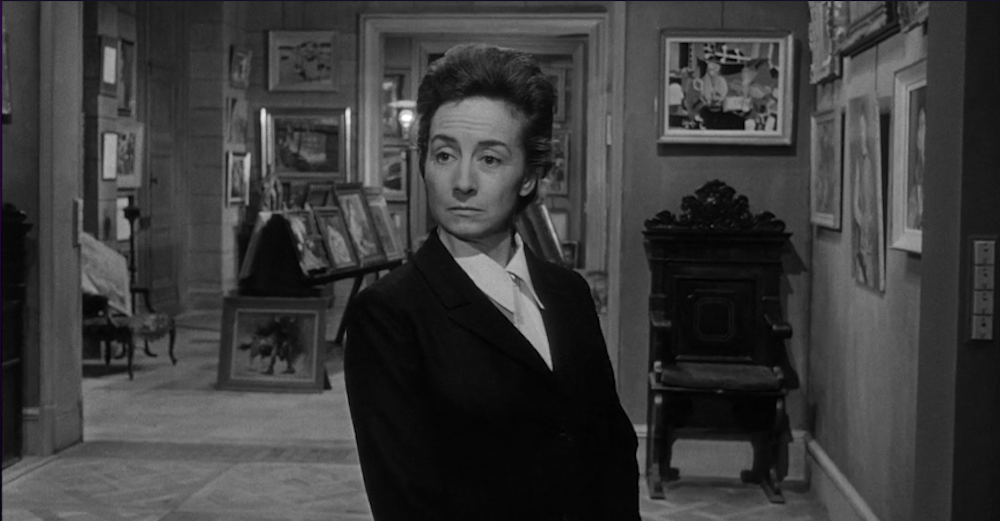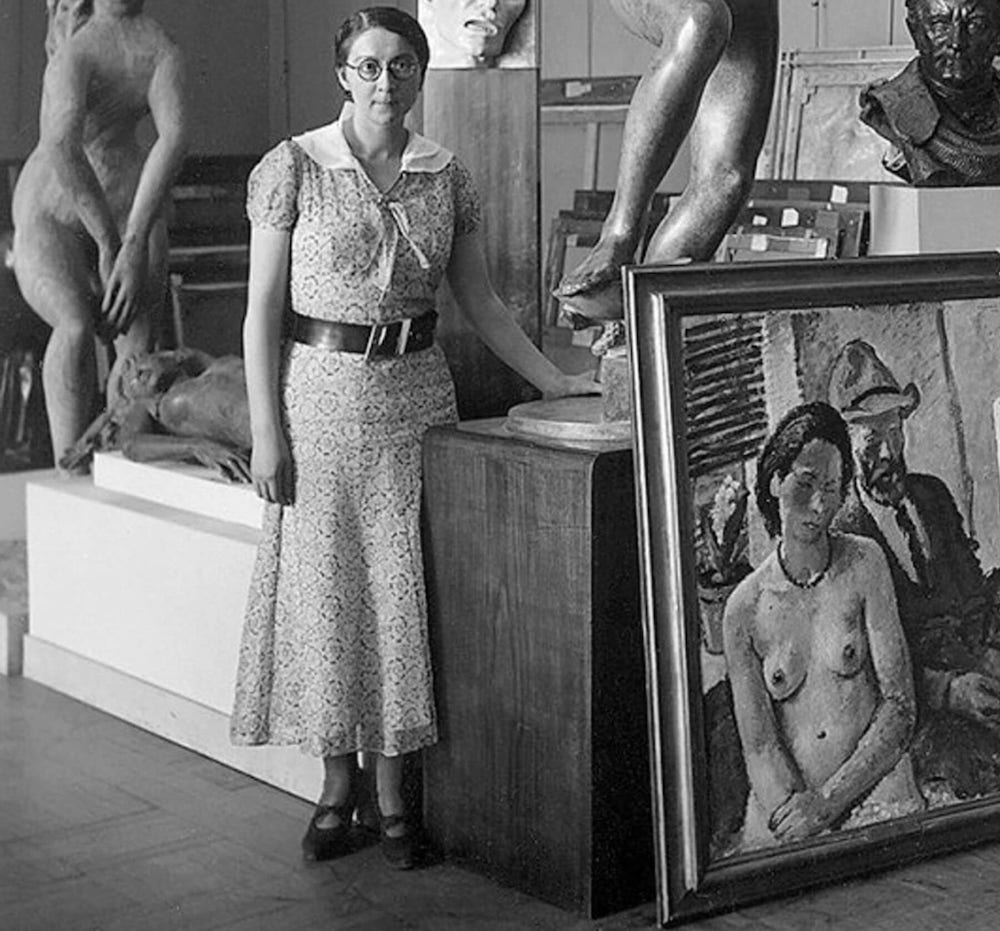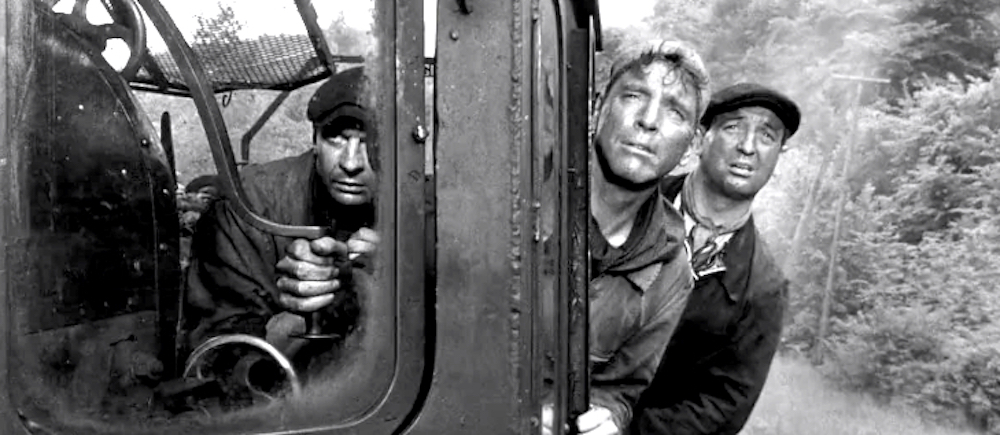| Courtney Kowalke |

The Train plays at the Trylon Cinema from Friday, September 27th, through Sunday, September 29th. Visit trylon.org for tickets and more information.
We, the makers of this film, wish to pay tribute to those French railway men, living and dead, whose magnificent spirit and whose courage inspired this story.
So opens John Frankenheimer’s nail-biter action film The Train (1964). Viewers don’t have to wait long for one of those real-world players to make an appearance. In the first five minutes, the fictional Colonel Franz Von Waldheim (Paul Scofield) surveys the interior of the Jeu de Paume Museum in Paris alongside a French curator referred to as “Mademoiselle Villard” (Suzanne Flon).
Villard is a stand-in for Rose Valland, a real woman and a real force in resisting the National Socialist German Workers’ Party’s rule in Paris. Valland was a French art curator who wrote the book on stopping the Nazi regime from looting art from the Jeu de Paume. Literally—Valland’s autobiography, Le front de art (The Art Front) served as loose inspiration for The Train’s screenwriters.
Despite originally training to be a high school drawing teacher, Valland was hired as a volunteer assistant curator at the Jeu de Paume in 1932. The Germans arrived in Paris in 1940. According to art historian Guillaume Deprez, “The Nazis forbade any French official to remain and witness a highly secret operation. But this unremarkable, unassuming woman assistant curator was allowed to stay.” Encouraged by French Musées Nationaux director Jacques Jaujard, Valland accepted a paid position and became the overseer of the Jeu de Paume, which became the Nazi’s main storage facility for artwork they had looted from other museums and private collections. Valland was 42 years old at the time.
Valland also neglected to mention to her Nazi supervisors that she spoke German. For four years, Valland secretly recorded conversations, translated copies of receipts for artwork that was moved, and tracked where the stolen pieces were being shipped to, information she regularly reported to Jaujard. According to historian Lynn H. Nichols, “[Valland] risked her life to provide information to the French Resistance about railroad shipments of art so that they would not mistakenly blow up the trains loaded with France’s priceless treasures.”1
The last one of these trains was the inspiration for, well, The Train. On August 2, 1944, the Nazis packed 148 crates of art from the Jeu de Paume into five train cars. However, they planned to ship 48 cars-worth of personal items stolen from deported citizens’ homes at the same time, and those cars still needed to be loaded. This gave Valland plenty of time to get a copy of the Nazi shipment order to Jaujard and for Jaujard to ask the railway workers to delay the train. Quote Deprez, “Between the time it took to load cheap furniture and the intentional sabotage, the ‘museum-train’ only advanced a few kilometers.” In other words, there were significantly fewer explosions and less machine gun action than in the film version.

Image sourced from The Collector
The Train may not be Valland’s story, but the fictional version of Valland gets the plot rolling. After Von Waldheim has the museum cleaned out and its art pieces packed up for sale, Villard approaches what remains of the French Resistance, including main character Paul Labiche (Burt Lancaster). Villard’s pleas that they stop the train containing the artwork are initially ignored—The Train opens on August 2, 1944, seventeen days before French Forces of the Interior began an uprising against the German forces and 23 days before Germany surrendered the city. Labiche and his crew have heard talk of Allied force approaching and don’t see the point in a big, risky rescue when they’re close to being free of the Nazi regime altogether.
“I won’t waste lives on paintings,” Labiche tells Villard.
“But they wouldn’t be wasted,” Villard argues. “I know that’s a terrible thing to say. But those paintings are part of France. The Germans want to take them away. They’ve taken our land, our food. They live in our houses, and now they’re trying to take our art. This beauty, this vision of life born out of France, our special vision, our trust. We hold it in trust. Don’t you see? For everyone. This is our pride, what we create and hold for the world. There are worse things to risk your life for than that.
Villard’s comment about how important maintaining this artwork is not only for the art world but for everybody really struck me. Here in Minneapolis in 2024, the Walker Art Center recently closed its exhibit, “Keith Haring: Art Is for Everybody.” “The public has a right to art,” Haring wrote in his journal circa October 1978. “The public is being ignored by most contemporary artists / The public needs art, and it is the responsibility of a ‘self-proclaimed artist’ to realize the public needs art, and not to make bourgeois art for the few and ignore the masses. / Art is for everybody. To think that they—the public—do not appreciate art because they don’t understand it… may mean that the artist is the one who doesn’t understand or appreciate art and is thriving in this ‘self-proclaimed knowledge of art’ that is actually bullshit.”2
Art is not made by the elite for only the elite to enjoy. Even when the rich hoard it, most art still reflects the lived experiences of the common people of any given era. Art is for everybody in 2024, just as it was in 1944.

Image sourced from Trailers From Hell
Art is for everybody in The Train as well. When his co-worker mentions some of the paintings on the train are by Pierre-Auguste Renoir, the typically ornery lead engineer Papa Boule (Michel Simon) cracks a smile and muses that he used to know a girl who modeled for Renoir. The highly-celebrated actress Jeanne Moreau receives third billing for playing “Christine,” an ally to the heroes, but Christine is not a fellow spy or a soldier or even a museum curator. She’s a widowed innkeeper who just helps Labiche. After Labiche’s cohort Jacques (Jacques Marin) is killed, Labiche and company receive help from some of Jacques’ friends and fellow railroad workers. Hell, Labiche himself isn’t a military man—he’s the area inspector for France’s national railway system. She may not be the main character, but The Train captures Valland’s spirit. It’s about people who go ignored doing their jobs to protect some of this world’s rare beauty.
Highlighting these ordinary people was in fact Frankenheimer’s goal with The Train. “The point I wanted to make was that no work of art is worth a human life,” Frankenheimer said in a 1969 interview. “That’s what the film is about. I feel that very deeply.”3 Frankenheimer wished to pay tribute to the people who inspired this story, and that meant showing how the people on the ground were major players, how heroes didn’t need to be determined by class or rank. Frankenheimer believed in the importance of how people thought and felt regardless of their station, and The Train couldn’t be a better showcase of these beliefs.
Sources
1 William R. Ferris, “On the trail of lost art: a conversation with Lynn H. Nicholas,” Humanities; May/Jun 2001 22.5. 4-49.
2 Keith Haring, Keith Haring Journals, Penguin Books, 1982, 48.
3 Gerald Pratley, The Cinema of John Frankenheimer. The International Film Guide Series, A. S. Barnes & Company, 1969, 125.
Edited by Olga Tchepikova-Treon
